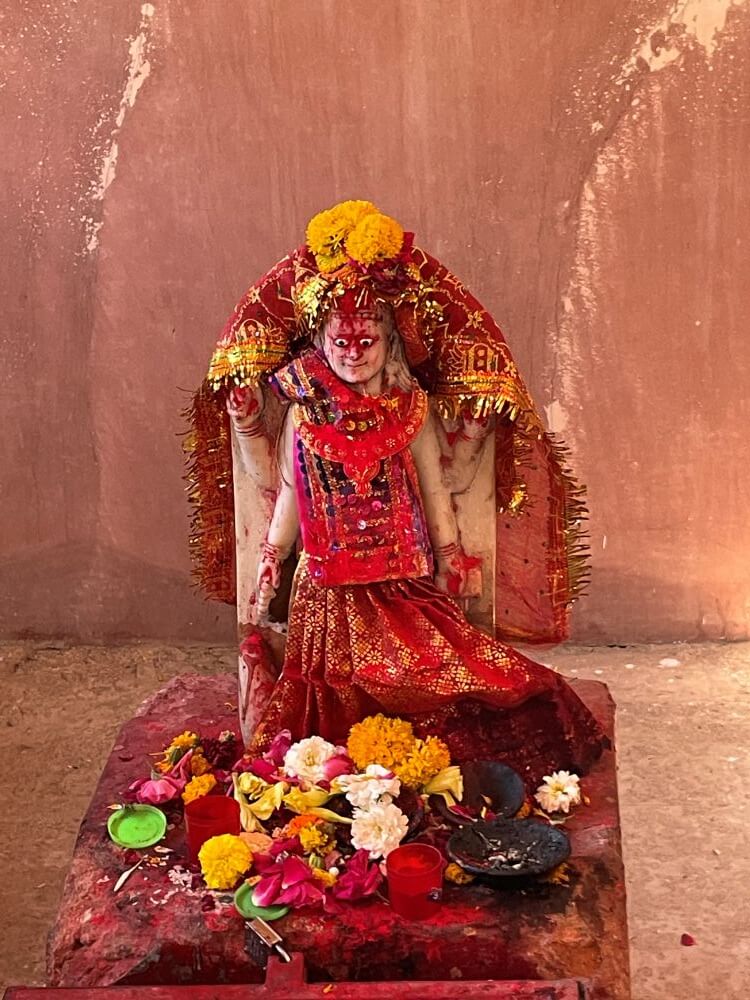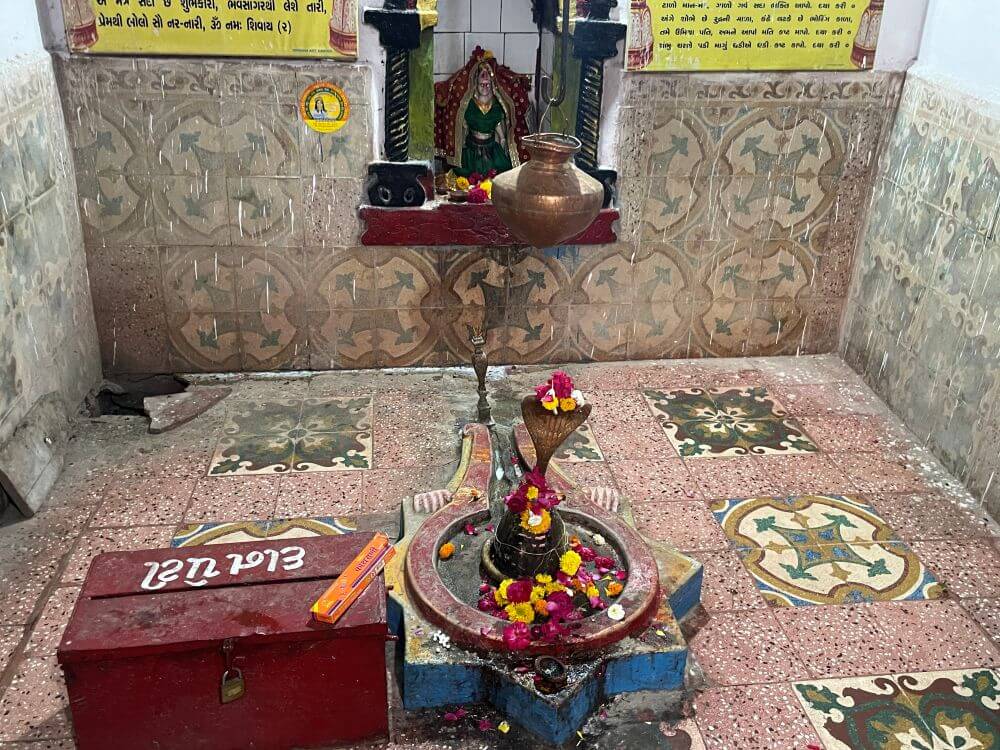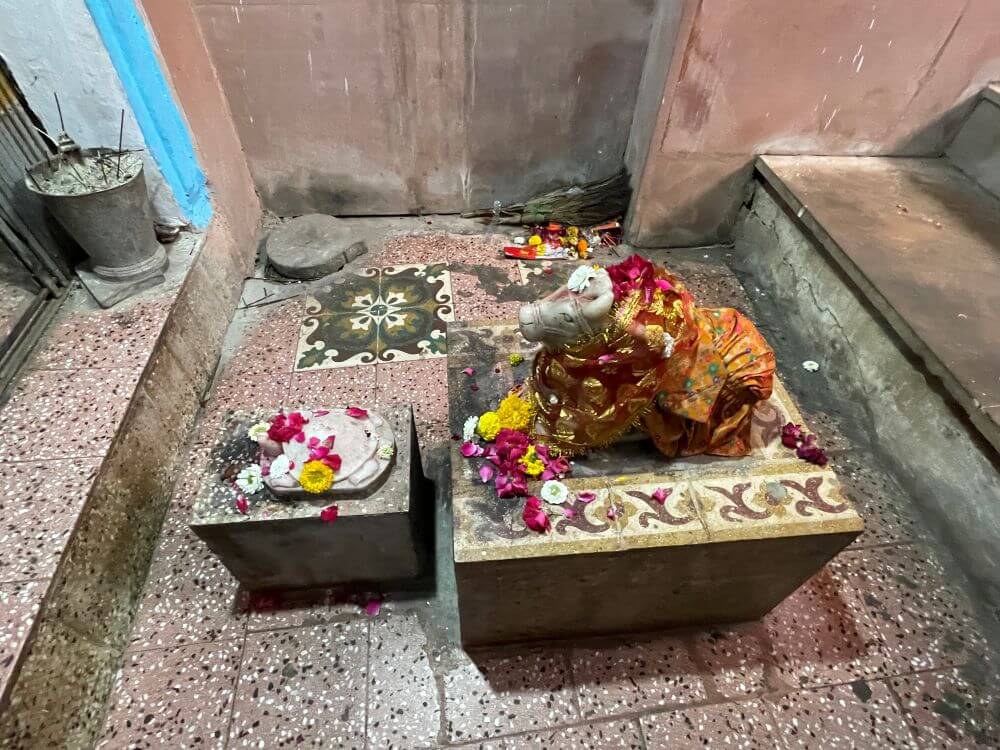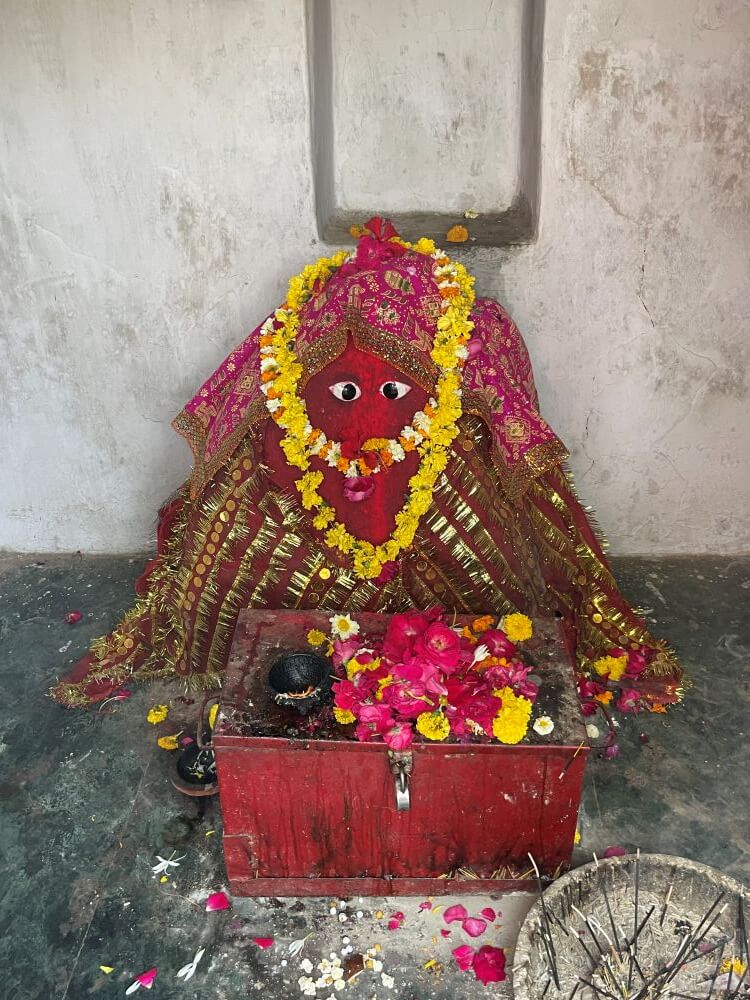 The renowned temple dedicated to Bhadarwa Dev, revered for sacrificing his life for cow protection, is located near Bhadarwa village in Narmada district. Worshipped as the guardian deity of cows, this deity is also popularly known as ‘Bhathiji Maharaj’. Situated atop a hill approximately 225 feet high near the village, this deity is revered by lakhs of tribal devotees from Gujarat, Maharashtra, and Madhya Pradesh. Devotees firmly believe that worshipping this deity protects them from snake and scorpion bites. More than five lakh devotees come here every year on foot during the Kartik Purnima festival.
The renowned temple dedicated to Bhadarwa Dev, revered for sacrificing his life for cow protection, is located near Bhadarwa village in Narmada district. Worshipped as the guardian deity of cows, this deity is also popularly known as ‘Bhathiji Maharaj’. Situated atop a hill approximately 225 feet high near the village, this deity is revered by lakhs of tribal devotees from Gujarat, Maharashtra, and Madhya Pradesh. Devotees firmly believe that worshipping this deity protects them from snake and scorpion bites. More than five lakh devotees come here every year on foot during the Kartik Purnima festival.
Bhathiji Maharaj is a folk deity of Gujarat, worshipped in the form of a heroic warrior. In the second decade of the 16th century, the Sultanate of Gujarat became unstable. Observing this weakness, Mughal emperor Humayun attacked Gujarat in 1535. Thereafter, the Mughals attacked Gujarat multiple times. Finally, in 1573, Emperor Akbar conquered Gujarat after defeating the last Gujarat Sultan Muzaffar Shah III. Amid this chaotic period, it is said that Bhathiji Maharaj was born in 1544 CE.
The legend concerning Bhathiji states that around five hundred years ago, Raja Rathod Takhtsinghji of the Bhati Kshatriya Rathod lineage ruled Fagvel (Taluka Kathlal, District Kheda) in Gujarat. This devout king was married to Akkalba, a Kshatriya lady from the royal family of Chikhlod village. The couple had four children – two daughters named Sonba and Binjiba, and two sons named Hathiji and Bhathiji. Bhathiji was born on Kartik Prathama of Samvat 1600. At the age of one and a quarter months, a symbol resembling a cobra appeared on his forehead. Fearless and brilliant, Bhathiji participated in people’s joys and sorrows since childhood. He was considered the incarnation of the Nag deity (snake god). He saved many lives from snake bites.
a Kshatriya lady from the royal family of Chikhlod village. The couple had four children – two daughters named Sonba and Binjiba, and two sons named Hathiji and Bhathiji. Bhathiji was born on Kartik Prathama of Samvat 1600. At the age of one and a quarter months, a symbol resembling a cobra appeared on his forehead. Fearless and brilliant, Bhathiji participated in people’s joys and sorrows since childhood. He was considered the incarnation of the Nag deity (snake god). He saved many lives from snake bites.
His marriage was arranged with Kankuba from Doodhatal. While taking the marriage vows, news reached him that the Muslim king of Kapadvanj had seized the village’s cows. Leaving the marriage ceremony midway, he immediately took up his sword and mounted his horse to fight against the enemy. While battling bravely, he was struck from behind by an enemy soldier, decapitating him. However, even after this, Bhathiji continued to fight headless until the last enemy soldier was slain. Since then, Bhathiji Maharaj has been worshipped as a folk deity who sacrificed himself for cow protection. Rathod Rajputs in Saurashtra worship him as their family deity. According to legend, Bhathiji Maharaj manifested spontaneously (Swayambhu) on the densely forested hill near Bhadarwa village. It is also said that Bhathiji Maharaj’s severed head fell upon this hill.
Presently, a large temple dedicated to Bhathiji Maharaj has been constructed here.  There are two ways to reach the temple on this high hill – one is via stairs, the other a road for vehicles. After ascending the stairs, one reaches the grand entrance gate of the temple courtyard. This entrance gate has four pillars, above which a large arch is erected. Within this arch is a statue of Bhathiji Maharaj mounted on a horse, sword in hand.
There are two ways to reach the temple on this high hill – one is via stairs, the other a road for vehicles. After ascending the stairs, one reaches the grand entrance gate of the temple courtyard. This entrance gate has four pillars, above which a large arch is erected. Within this arch is a statue of Bhathiji Maharaj mounted on a horse, sword in hand.
Ascending further stairs leads to a shrine dedicated to Mahakali Mata in a wall niche. Additionally, the temple complex houses smaller temples and shrines dedicated to deities such as Hadkai Mata, Adisingh Chauhan, Santoshi Mata, Hanuman, Narmada Mata, Kalika Mata, Bariya Dev and Rameshwar Mahadev. Below the main temple is the temple of Pardeshwar Mahadev, who resides here in the form of a subterranean Shiva Ling (Patal Ling).  After descending around 25 steps, devotees enter the sanctum sanctorum. Inside, upon a marble platform is a marble idol of Nandi, and in front is the Shivling placed on a star-shaped pedestal. A brass serpent forms a canopy above the Shivling. On the rear wall of the sanctum, there is an idol of Goddess Parvati in a small niche.
After descending around 25 steps, devotees enter the sanctum sanctorum. Inside, upon a marble platform is a marble idol of Nandi, and in front is the Shivling placed on a star-shaped pedestal. A brass serpent forms a canopy above the Shivling. On the rear wall of the sanctum, there is an idol of Goddess Parvati in a small niche.
The primary temple of Bhadarwa Dev (Bhathiji Maharaj) is situated at the highest point. The temple consists of an open assembly hall (Sabhamandap) with a flat roof and square pillars, and a sanctum. The sanctum has an Urushringa-type spire (Shikhar) crowned by an Amalaka and Kalash. The sanctum has two entrances. Inside, there is a large, vermilion-covered sacred stone (Tandala) representing Bhadarwa Dev. The stone is wrapped in silk cloth and adorned with a red turban.  On the external wall to the right of the sanctum, there is a large painting of Bhathiji Maharaj, also worshipped by devotees. Near one tree in the temple complex stands another statue of Bhathiji Maharaj mounted on horseback holding a sword in his left hand. Several smaller sacred stones are placed nearby, which devotees also worship.
On the external wall to the right of the sanctum, there is a large painting of Bhathiji Maharaj, also worshipped by devotees. Near one tree in the temple complex stands another statue of Bhathiji Maharaj mounted on horseback holding a sword in his left hand. Several smaller sacred stones are placed nearby, which devotees also worship.
Numerous devotees visit the temple during Guru Purnima. On this day, a grand feast (Mahabhandara) is arranged for devotees. A major festival is held on Kartik Purnima. Organized by the district administration and the Bhadarwa Dev Temple Trust, lakhs of devotees walk in groups towards the temple starting from Chaturdashi. Hundreds of tribal devotees dressed in traditional attire come playing drums and musical instruments. Many male devotees from tribal communities arrive dressed as women. During this festival, devotees offer horses made of gold, silver, or even paper to the deity. Devotees from the potter community offer clay horses, while those from the tailor community offer silk horses.
Every year, the Akhil Bharatiya Narmada Parikrama Seva Sangh arranges free tea and resting facilities for pilgrims. Recitation of Sundarkand and evening devotional sessions (bhajans) are also organized. A grand feast is hosted for devotees during this festival. From the temple premises, visitors can also see the ‘Statue of Unity’, dedicated to Sardar Vallabhbhai Patel, built near the Sardar Sarovar Dam.
